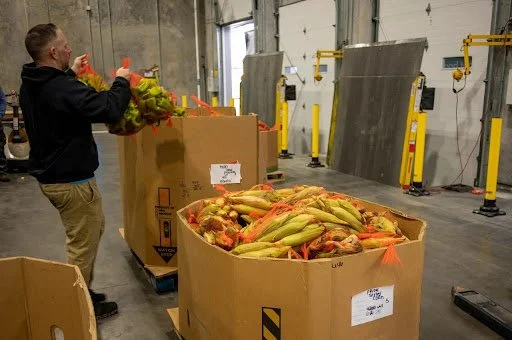SNAP Program Stretched Thin: Delays in Benefits Expose Weak Links in Federal and State-Based Aid
Foodbank of Central and Eastern North Carolina employees load up fresh produce on Nov. 2, 2025, in a Wilmington warehouse to distribute to food pantries across the city. Source: Carolina Public Press.
On Monday, October 27, 2025, the North Carolina Department of Health and Human Services announced that 1.4 million North Carolinians would see delays in their Supplemental Nutrition Assistance Program (SNAP) benefits if the federal government shutdown continued into November. While these funds come from the federal government, many states have begun to release funding for SNAP recipients for their constituents. Maryland Gov. Wes Moore has released $62 million for Maryland residents who rely on the program. This supplemental aid from the states themselves is raising questions of whose responsibility it is to keep essential services open during federal shutdowns.
In North Carolina, Governor Josh Stein has pledged $10 million in state funds to food banks, along with another $8 million in private donations, but has made it clear that he believes these funds are not a final solution. Stein commented that the state’s contributions are not a final solution and that the federal government ultimately needs to fully fund SNAP.
North Carolina is also a unique case in allocating money from the state budget to SNAP, as the NC General Assembly (NCGA) has yet to pass a comprehensive state budget, even though the deadline was July 1 of this year. Though working with NCGA members to address Medicaid funding, Stein has maintained that it is the federal government’s failure to pass a budget that’s responsible for the SNAP crisis now hitting families across the state.
This situation underscores a structural vulnerability in the nation’s safety net where states are tasked with administering programs like SNAP, but lack the power to sustain them when federal funding halts. These concerns also come as the USDA announced it will not be using the roughly $6 billion in federal contingency funds, reserve funds available in case regular funding is insufficient, to keep the SNAP program running for November or reimburse any state funds used to cover SNAP benefits during the shutdown. Even with states utilizing emergency contingency funds to help families in need, existing federal funding contingencies make it so states will likely have to issue prorated benefits, meaning households only receive a partial amount of the money they are owed that month.
Ultimately, while states can partially help their constituents who rely on SNAP, Gov. Stein emphasized that without an end to the federal shutdown, families relying on SNAP will not be able to afford food as the holiday season begins and temperatures cool. He described the crisis as “a cruel abdication of responsibility,” which reflects a broader public frustration, as 48% of Americans have expressed that they feel the shutdown is affecting their communities; and with some states having larger reserves to fund their SNAP programs, families in need are seeing disproportionate coverage based on where they live. While VA Governor Glenn Youngkin and Maryland Governor Wes Moore can use state revenue surpluses to help their state, Stein insisted that he doesn’t “have access to unlimited resources” nor was he as prepared as other legislators to fill in the gaps.
The struggle over SNAP in North Carolina and other states around the country reveals tensions between the state and federal government’s funding responsibilities. When congressional negotiations stall, the consequences reach far beyond just Washington. The federal government building stronger safeguards to protect programs like SNAP from shutdowns would prevent the uncertainty that leaves states scrambling and families in certain states receiving more support than those living elsewhere. For families facing delayed or reduced SNAP benefits, the government shutdown is not just a policy issue; it directly affects their ability to meet basic needs.

